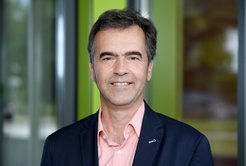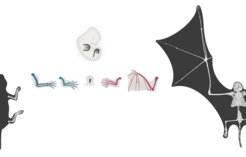Stefan Mundlos receives an Advanced Grant from the European Research Council
The genomics of evolution: how bats learned to fly
Berlin researcher Stefan Mundlos has been awarded a prestigious ERC Advanced Grant. The funding program of the European Research Council (ERC) is one of the most distinguished in Europe. Mundlos wants to investigate the gene regulatory mechanisms that led to the development of bat wings during evolution. For this project, the ERC is providing around €2.5 million over a five-year period to Mundlos and his team.

The forelimb anatomy of a bat embryo at first resembles that of other mammals. But then the arm bones and fingers grow longer and longer, a forearm bone regresses, and skin-covered wings develop. The result is the only mammal capable of true flight, one that is uniquely adapted to its habitat.
“Developmental genes need to be activated in a precise temporal order to develop a bat wing instead of a paw,” says Stefan Mundlos, Director of the Institute of Medical Genetics and Human Genetics at Charité – Universitätsmedizin Berlin and Research Group Leader and External Scientific Member at the Max Planck Institute for Molecular Genetics (MPIMG).
Mundlos and his team are investigating which genetic mechanisms control normal skeletal development and how malformations occur during this process. “We want to find out how the genomic sequence determines the development of entire organ systems and the different animal shapes through the interaction of genes,” Mundlos says. Here, the scientists are focusing especially on limb development and seeking answers to the question, “How can the same part of the body develop completely different shapes in different mammalian species?”
The arsenal of modern genomics
What causes the external shape of an organism? How is this biological process – known as morphogenesis – controlled by non-coding elements in the genome? Mundlos has been working on these questions for a long time. He and his team will use the ERC grant to identify and study in detail such non-coding regulatory sequences in bats. In order to characterize the function of these relatively large genome segments in gene regulation, the researchers plan to synthesize them in yeast using synthetic biology technologies and then investigate them further.
By comparing mouse and bat limb development, they want to learn which genetic “switches” are necessary for the formation of wings and which principles determine how they work together. Their research intends to clarify fundamental questions such as: Which elements control gene activity in the organism? What is the effect of sequence differences in these control elements? How are evolutionary adaptations in morphology encoded in the genome?
In addition, the newly developed technology could significantly improve functional analyses of mammalian genomes in the future. This applies especially to the investigation of non-coding DNA elements and their function in normal development and in disease. New insights into the function of non-coding DNA are necessary to better understand the role of this part of the genome in the development of genetic diseases.

Evolutionary adaptation through variable developmental programs
“Imagine the genome as a toolbox,” Mundlos says. “The genes are the tools that can build an organism. In addition, there are the instructions – the gene regulatory elements – that determine in which order which tool is used.” Evolution uses all these resources but prefers to vary the instructions so as to modify existing structures in such a way that they develop the desired characteristics.
“Developmental genes are almost identical in various mammalian species, but differences in gene regulation create incredible diversity,” Mundlos explains. “Bat limbs are an extreme morphological example. This makes them particularly interesting for our studies, because we expect correspondingly strong variation in gene regulation as well.”
In bats, forelimbs and hind limbs differ much more in shape and function than in most other mammals. Although they have delicate wings at the front, they have small paws at the back that can hold on to branches or edges of rock. Nevertheless, apart from a few exceptions, the same genes are responsible for the development of fore and hind limbs.
The interaction between the factors that create this diversity is still poorly understood, Mundlos says, pointing that we don’t “understand how enhancers, promoters and other regulatory components work together to control and fine-tune gene expression.”
Differences beyond genes
Regulatory sequences belong to the non-coding regions of the genome that make up about 98 percent of DNA. They don’t contain blueprints for proteins, but control gene expression, i.e., whether and when a gene gets transcribed and how much protein is produced as a result.
DNA segments such as enhancers and promoters determine in which tissue and under what circumstances genes are switched on or off. Enhancer regions can be located far away from their target gene, while promoter sequences are always in close proximity to their corresponding gene. What’s more, there are epigenetic regulators – factors that chemically modify the “packaging” of DNA to prevent access by the cellular machinery, but don’t affect the underlying genetic information.
Several years ago, Mundlos’s group demonstrated that changes in DNA non-coding regions can lead to disease. Deviations in its sequence may lead to structural changes in the genome’s 3D structure: the string of DNA will no longer arrange itself in the necessary loops, resulting in faulty gene regulation.
These are only examples of the multitude of processes that have to work together so that genes, gene regulatory sequences, epigenetic modifications and other control factors produce a desired result. The overall process is complex and difficult to grasp, Mundlos says, adding that “the mechanisms that control the expression of genes and ultimately the appearance of an organism are not yet well understood.”
“How information encoded in DNA is translated into an external phenotype is a very central question in biology that is still basically unanswered,” the researcher says. “But now we have the technology to look at this problem in a fundamentally new way.”
About Stefan Mundlos
Stefan Mundlos studied medicine at the Universities of Göttingen, Marburg and Heidelberg and also studied abroad at the University of California in San Diego in the USA and at the University of Melbourne in Australia. He received his medical doctorate in 1986 and subsequently completed his residencies in Pediatrics (1992) and in Human Genetics (1998) at the Children’s Hospital of the University of Mainz. From 1993 to 1994 he worked as a research fellow at the Royal Children’s Hospital and Murdoch Institute for Research into Birth Defects at the University of Melbourne. This was followed by a research stay at Harvard Medical School in Boston in the USA, before going on to qualify as a professor at the University of Mainz in 1997. From 1998 to 2000 he held a professorship in developmental genetics at the Institute of Human Genetics in Heidelberg. In 2000, he was appointed Director of the Institute of Medical Genetics and Human Genetics at Charité – Universitätsmedizin Berlin and simultaneously Research Group Leader at the Max Planck Institute for Molecular Genetics (MPIMG). In late 2017, the Senate of the Max Planck Society appointed him as an External Scientific Member of the MPIMG.
About the European Research Council
The European Research Council (ERC), set up by the European Union in 2007, is the premiere European funding organization for cutting-edge basic research. Each year, the ERC selects and funds the best and most creative researchers of any nationality and age to carry out projects in Europe. The ERC offers four core grant schemes: Starting Grants, Consolidator Grants, Advanced Grants and Synergy Grants. All programs are designed to fund risky but groundbreaking “frontier” research. The sole selection criterion for all projects is the scientific excellence of the applicant and their project idea.













